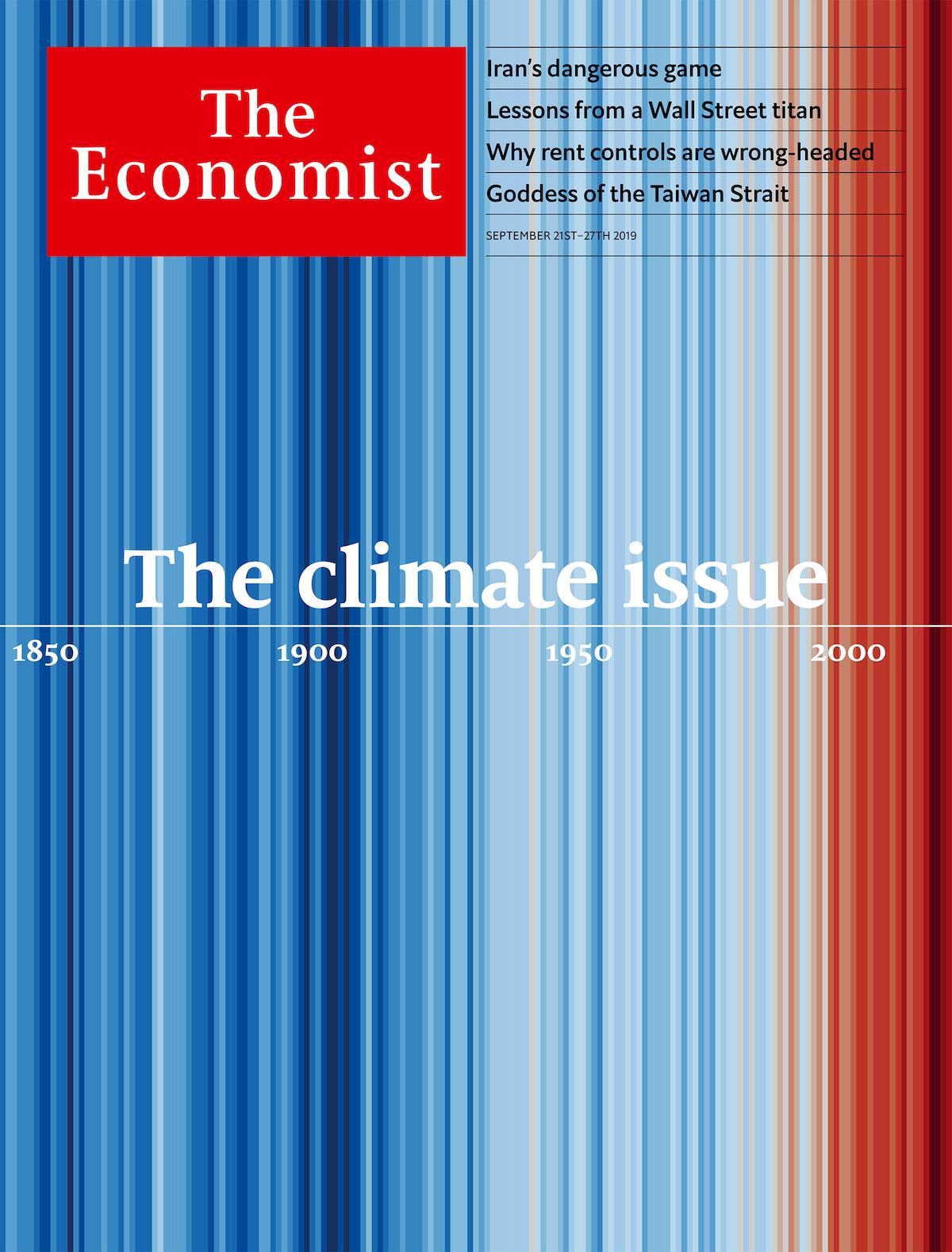Magazines elevate storytelling to focus on climate change
“We want people to be better prepared to deal with the future”
Many people will be talking about the issue of climate, explained Mark Cripps, CMO at The Economist. “We want to be part of the conversation and make sure the facts about climate change are known,” he said. “We want people to be better prepared to deal with the future and Climate Week seemed the ideal time to start this climate initiative. Many people will be paying attention.”
In the Saturday, September 21 edition, The Economist treated climate change in four different ways:they dedicated their weekly issue to climate change, they announced the winner of their Open Future essay contest, the films and radio teams produced content on climate topics, and as a company, they committed to eco-friendly activities.
 |
Larissa Parker, winner of The Economist’s Open Future essay competition. Read the essay here.
In the edition, in addition to the cover, lead article and briefing, every section of The Economist includes an article on climate change. By including a climate article in every section of the paper, the editors are emphasising how climate affects every aspect of the world in which we live, explained Cripps. There are a range of climate articles throughout the newspaper including: what the US’s Green New Deal is and what it should be; how Britain advanced offshore wind energy and what industrial policy lessons can be learned from it; how the threat of extinction makes small-island states a power in climate diplomacy; what rainfall changes mean for the Panama canal, and for farmers in Malawi; and how business seeks to respond to the crisis. The Economist Films and Radio teams also produced video and audio on climate topics covered in the September 21st issue.
In addition, parent company The Economist Group is committing to eco-friendly actions on the commercial side of the business, including swapping out their plastic wrappers to a 100 per cent home compostable starch based Bio-Plast film for UK subscribers.
“Our journalists developed both the issue and the Open Future essay contest question – the timing is not a coincidence,” Cripps said. “It was a combined effort from the leadership on our commercial side,” Cripps said. “Our editor-in-chief informed us about the issue and we went to work brainstorming how we could implement some eco-friendly activities in a business format.”
As part of The Economist’s experiential marketing activity, they’re also offering New Yorkers a free coffee in an edible cup. “Those who take us up on the offer will receive their coffee in a consumable coffee cup that people can enjoy as a crispy treat after they have drunk their coffee,” Cripps explained. “The cup, which is made from natural grain products, stays crisp for 40 minutes once coffee is poured in. The edible coffee cup is vegan and can be used for hot and cold beverages.”
New Yorkers’ caffeine hit was served from a pop up cart made of repurposed plastic bottle cap art and offered in exchange for plastic trash. The plastic trash collected from this activity will be given to the Brooklyn based plastic collection charity, ‘Sure We Can,’ Cripps said.
“With this eco-friendly commercial activity, we are not simply telling people that climate change has an impact on every part of life; we are showing them that it is. On the commercial side, we wanted to show our support and commitment to the same cause by implementing a few different eco-friendly initiatives. In this way, we have come together as one organisation to shine a light on climate.
 |
To cap their effort to promote awareness on climate change, The Economist is running a special subscription offer: every new subscription taken out will plant a tree in The Economist forest. “When we sell a subscription as part of our experiential marketing activity in New York, The Economist will plant a tree,” Cripps said. “This is being done through Tree-Nation, which will plant a tree in The Economist forest. Through this activity we hope to introduce people to our content, sell subscriptions and give our customers a chance to tackle climate change in a small way.”
To date, The Economist has planted 156,353 trees, which have offset 13,891.24 tons of CO2.
“An opportunity and responsibility to use it to go deep on important issues like this.”
The Economist wasn’t the only publication to do a deep dive on climate change, and elevate their storytelling to do so. In mid-September, Time magazine came out with a special issue on climate change, called 30 Years to Save the Earth. The climate issue marked the 30th anniversary of Time’s “ Endangered Earth” Planet of the Year issue.
Three decades ago, wrote editor-in-chief Edward Felsenthal in his editor’s message, “Time convened a group of 33 scientists and political leaders from five continents in Boulder, Colorado, to discuss the threat of climate change. The result was one of the best-known issues Time has ever produced, sounding one of the louder alarms to date… Three decades from now, we will be on the cusp of 2050, the year by which we must have already acted—with urgency as outlined by the U.N.’s Intergovernmental Panel on Climate Change—to have any chance of keeping average global warming to 1.5°C above 19th century levels.”
“I have always loved The Endangered Earth cover by Christo,” Felsenthal said in an email to FIPP. “I think it’s one of the most powerful in Time’s history. I hadn’t realised until we began the work on this year’s issue the degree to which Time really helped sound the alarm about the need for climate action 30 years ago, or that the editors had convened such an amazing group of people from around the world to produce it. This seemed like an important opportunity both to assess how far we’ve come in addressing the threat, as well as how much farther there is to go.”
 |
The 30 Years to Save the Earth issue became more than a single issue; it was a package of multimedia and mixed media elements that took Time’s high-quality journalism and elevated it to something more. The issue included a major feature by American environmentalist, author, and journalist Bill McKibben on solving climate change and opinion columns from high-profile individuals Al Gore and Dr. Jane Goodall. The issue also featured features on climate issues from every continent, artwork by youth, and a list of 12 female climate optimists. Time also launched a bi-weekly newsletter, One.Five, which aims to connect the dots on climate change and show how the phenomenon affects all aspects of life. Felsenthal said, “Time has one of the biggest platforms in the world. That gives us both an opportunity and responsibility to use it to go deep on important issues like this, through reporting and innovative storytelling.”
Time also took their storytelling above and beyond for the new cover, with a drone photograph of a massive scale sculpture made of sand by artist Toshihiko Hosaka, depicting the Time logo and border and the Earth.
“What do you do after Christo? Tough act to follow!” Felsenthal said. “As we were thinking about possible covers, our creative director DW Pine reached out to Toshihiko Hosaka and immediately saw the potential to do something unique and powerful. I love that the cover for this issue comes from the sand, from the earth itself.”
***DW Pine will speak about Time’s award winning design at the FIPP World Media Congress, taking place from 12-14 November in Las Vegas. See the speaker line-up here and the agenda here.
The FIPP Congress reunites 600+ media executives from around the world. Book your tickets here.***
Felsenthal wrote in his editor’s message: “It is a moment we can rise to—and that is the message of the cover of this issue, a sand sculpture created on the shores east of Tokyo by the Japanese artist Toshihiko Hosaka and photographed by drone. Like the shared work of mitigating climate change, Hosaka’s cover is the result of collective action—a seven-person team worked together for 14 days, dodging a typhoon along the way, to create a visual statement out of the earth itself.”
And, complementing one of the print features, Time released a new AR activation called “The Amazon.” The AR activation was filmed using drones and photogrammetry by two AR producers from Time and reporter Matt Sandy, who visited some of the most remote and difficult to reach locations currently under threat of deforestation in the Amazon.
“We also wanted to make sure that Time’s Climate issue was global in perspective, and we set out to tell stories from every continent through our reporting,” Felsenthal said. “For example, there is no place on earth where the climate crisis is as dire as it is in the Amazon rainforest and we felt that telling the story of what is happening in the Amazon through AR would enable readers to experience it in an entirely new way. Jane Goodall’s moving narration added even more to this disturbing and stirring experience.”
The experience will be available in Time’s AR/VR app, Time Immersive.
More like this
How The Economist successfully engages younger readers
Time launches AR and VR app, moves forward with immersive experiences
From Vegas to Hollywood: Make the most of your time with FIPP
Behind Insider’s rewritten and illustrated Mueller Report
Magazines join fight against single-use plastics by looking into alternatives to polybagging
Global entertainment platform Fandom brings on former Condé Nast EVP









